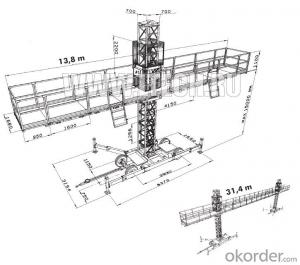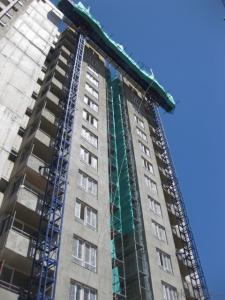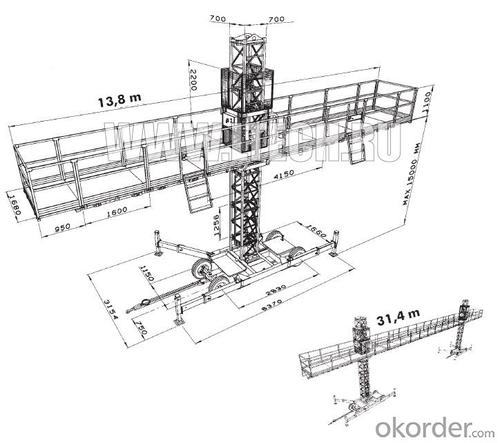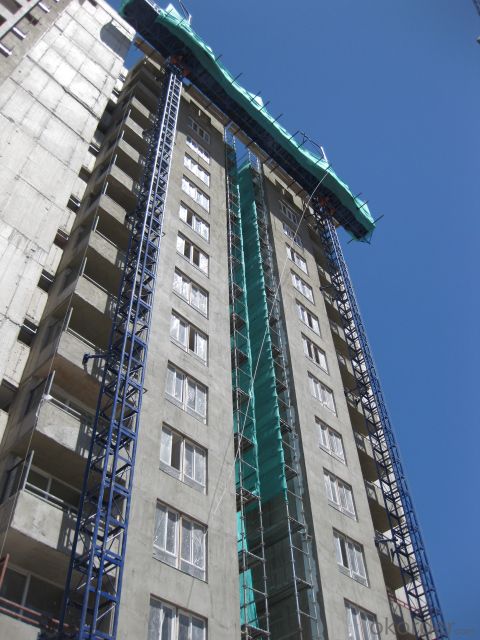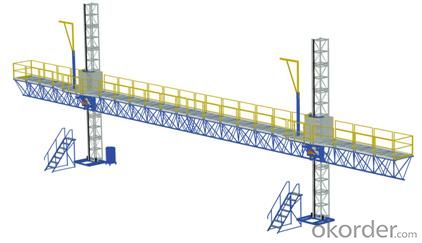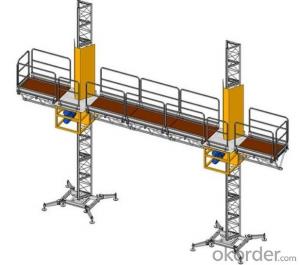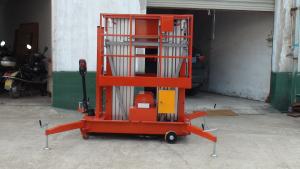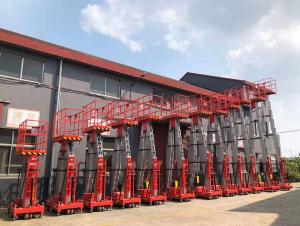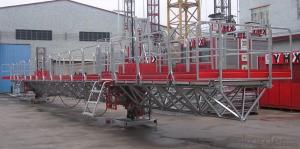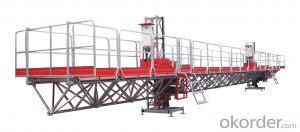SCP200 double Mast Climbing Work Platform
- Loading Port:
- Tianjin
- Payment Terms:
- TT or LC
- Min Order Qty:
- -
- Supply Capability:
- 15 units unit/month
OKorder Service Pledge
OKorder Financial Service
You Might Also Like
Building Hoist SCP200
Condition: New
Application: Construction
Payload(kg):2000
Lifting Speed(m/min):0~33
Motor Power(kw): 3*22
Safety Device: 2*SAJ50-1.4
Cage: Single/double cages
Counterweight: No
Certification: CE/ ISO
Place of Origin: China(Mainland)
Model Number: Type:SCP200
Packaging & Delivery of Building Hoist
Packaging Detail: Nude package Delivery Detail: 12-15days
Main Parts of Building Hoist
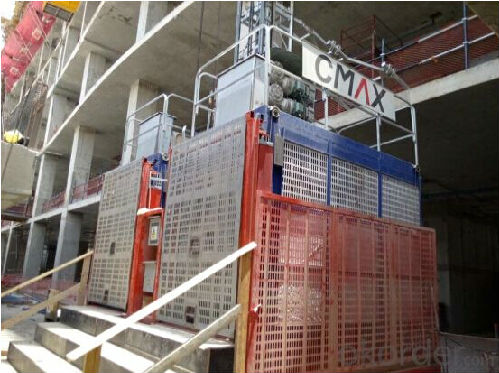
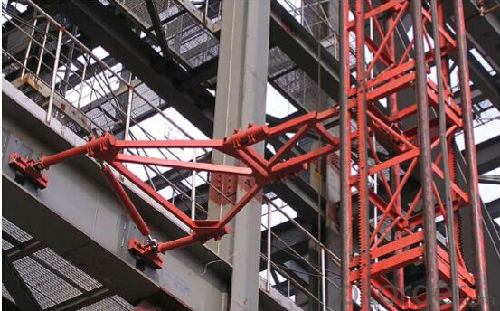

Feature:
● Adopts the most advanced VF speed control device and microcomputer programmable logic controller.
● Stepless speed control helps eliminate the concussion during start up and braking, steady the operation process,
and ensures automated leveling.
● avoid slipping during downward stopping of hoist.
● It reduces the engery consumption and mitigates effects to on site electric equipments.
● The steadiness during running mitigates concussion to mechanical parts, reduces wears of rack, pinion and the brake
and prolongs the spare parts'life.
● The VF system also has the over voltage protection,low voltage protection, overcurrent, overload and anti-stalling protection functions,
● The system applies the special software for hoists developed by our company, making the operation more safe and
reliable.
Building Hoist Specifiction
FAQ of Building Hoist
Q: What is the building hoist main purpose?
A: It's the ideal construction equipment for vertical transportation in the field of construction.
Q: What is the main structure of building hoist?
A: The P/M construction hoist mainly contains metal structure, driving system, electrical control system, cable guide &
protection system, electrical top crane and safety device.
Q: What is the meaning of the building hoist’s code?
A: Take SC200/200 for example: “SC” stands for rack and pinion hoist, “200/200” stands for double cage and capacity
is 2 tons per cage.
Q: What is the dimension of the cage?
A: Normally the cage dimension is 3X1.5X2.5M (L/W/H) for 2t type hoist. Details should be checked according to our
quotation sheet. Also, the size can be customized according to the factual site condition. It can be produced as up & down sliding or ramping model for safety and convenience.
- Q: This question asks for the method to determine the lifting capacity of a building hoist.
- <p>To calculate the weight that a building hoist can lift, you need to consider the hoist's rated capacity, which is specified by the manufacturer. This rating is based on safety factors and should not be exceeded. Check the hoist's specifications for its maximum load capacity. Ensure that the weight of the materials being lifted does not exceed this limit. Additionally, consider the hoist's mechanical condition, the strength of the cables, and the stability of the lifting points. Regular maintenance and inspection are crucial to ensure the hoist operates within its safe working load limits. Always follow the manufacturer's guidelines and safety regulations when using a building hoist.</p>
- Q: What about the energy efficiency of the escalator
- Construction elevator adopts frequency conversion stepless speed, smooth braking, small impact on the grid, and energy saving effect is obvious, ordinary construction elevator running speed is 36 m/min, motor, 3 * 11 kw; Frequency conversion construction elevator running speed can reach at low speed: 0-46 m/min, motor: 2 * 11 kw, whether in theory or in practical construction, energy saving effect is remarkable, some developed coastal areas in frequency conversion construction elevator as mainstream products has become a trend.
- Q: Explain the distinctions between electric and hydraulic building hoists, focusing on their mechanisms, efficiency, and applications.
- <p>Electric building hoists use electric motors to drive the hoisting mechanism, which can be more efficient and require less maintenance than hydraulic systems. They are often quieter, have fewer leaks, and can be more precise in their operation. Hydraulic building hoists, on the other hand, use hydraulic pressure to lift loads. They can handle heavier loads and are often used in situations where there is no electricity available. However, they may require more maintenance due to potential leaks and can be less precise in their movements.</p>
- Q: This question asks for an explanation on how to operate a winch, specifically in the context of a building hoist.
- <p>To use a winch, particularly a building hoist, follow these steps: Ensure the winch is securely anchored and the cable is in good condition. Attach the load to the hook, ensuring it's balanced. Turn the winch handle clockwise to lift the load; counterclockwise to lower it. Always keep tension on the cable to prevent it from slacking. Use a tag line to guide the load horizontally. Never exceed the winch's load limit. Regularly inspect the winch and cable for wear and tear. Always have a spotter to assist and communicate during the operation. Safety is paramount, so never leave the winch unattended while the load is in the air.</p>
- Q: How many meters or how many layers should the construction elevator be installed?
- In the guangdong area, the first installation and acceptance of the equipment will be below 7 levels, and more than 7 floors will be charged for the inspection. Another 9 meters per wall, the most suitable installation time is a building at least 12 meters, which can be installed at 21 meters in the evening.
- Q: How many people are there for construction workers
- The elevator is a vertical elevator with electric motors, which is equipped with box pods for multi-storey building and carrying goods. There is also a terrace, which is running continuously on the crawler, commonly known as escalator or automatic walkway. A fixed lifting device for the floor. Vertical elevator has a car, running on at least two columns of the vertical or Angle is less than 15 ° between the rigidity of rail. The size and structure of the car is convenient for passengers to enter or unload cargo. Traditionally, the elevator is the general term for vertical transportation in buildings, no matter how they are driven. Speed can be divided into low speed elevator (1 m/s), rapid elevator (1 ~ 2 m/s) and high speed elevator (2 m/s). Hydraulic elevators were introduced in the mid-19th century and are still being used in low-rise buildings. In 1852, the United States developed a safety elevator for wire rope lifting. In the 1980s, there was further improvement in drivers, such as the electric motors, which were driven by worm gears to turn the winding drum and balance weight. At the end of the 19th century, the friction wheel drive greatly increased the lift height.
- Q: Is it feasible to repair or replace a building hoist with ease?
- <p>The ease of repairing or replacing a building hoist depends on several factors. For minor issues, repairs can often be done relatively easily by trained technicians. However, for major malfunctions or when a hoist is outdated, replacement might be necessary. This process can be complex and requires expertise to ensure safety and compliance with building codes. Factors such as the hoist's age, the complexity of the system, and the availability of replacement parts play a significant role in determining the ease of repair or replacement. In some cases, it might be more cost-effective to replace rather than repair, especially if the hoist is old or if repair costs are high.</p>
- Q: This question asks whether a building hoist can be utilized for lifting various kinds of objects.
- <p>Yes, a building hoist can be used for lifting multiple types of objects. It is designed to handle a variety of materials, including construction materials, tools, and equipment. The hoist's capacity and design may vary, allowing it to accommodate different weights and sizes. However, it is crucial to ensure that the hoist's lifting capacity is not exceeded and that the objects are secured properly to prevent accidents. Always refer to the manufacturer's guidelines for specific weight limits and safety procedures.</p>
- Q: Is it possible for a hydraulic cylinder in a building hoist to be serviced or replaced by individuals other than the manufacturer?
- <p>Yes, a hydraulic cylinder in a building hoist can be repaired or replaced by qualified individuals or companies other than the manufacturer. However, it is crucial to ensure that the service provider has the necessary expertise and follows the manufacturer's specifications to maintain safety and performance standards. Using non-genuine parts or improper installation can lead to safety hazards and void warranties. It is always recommended to consult with professionals who are familiar with the specific hoist model and have experience in hydraulic systems repair and maintenance.</p>
- Q: Is it possible for a hydraulic cylinder in a building hoist to experience leakage or failure?
- <p>Yes, a hydraulic cylinder in a building hoist can leak or break. Leaks can occur due to worn seals, damaged hoses, or corroded cylinder walls. Breakage may result from excessive pressure, manufacturing defects, or metal fatigue. Regular maintenance and inspection are crucial to detect and prevent such issues, ensuring the safety and efficiency of the hoist system.</p>
Send your message to us
SCP200 double Mast Climbing Work Platform
- Loading Port:
- Tianjin
- Payment Terms:
- TT or LC
- Min Order Qty:
- -
- Supply Capability:
- 15 units unit/month
OKorder Service Pledge
OKorder Financial Service
Similar products
Hot products
Hot Searches
Related keywords
